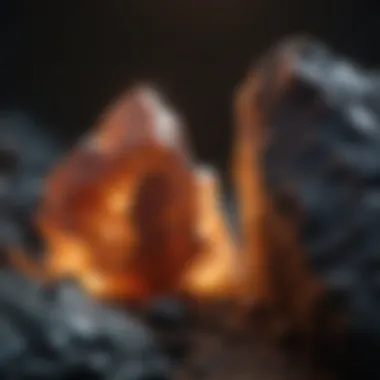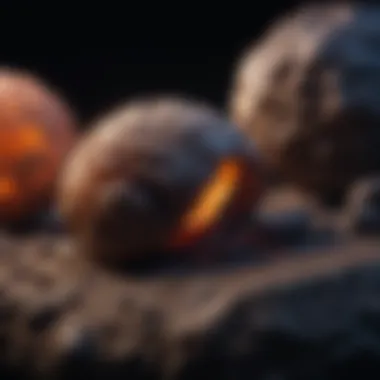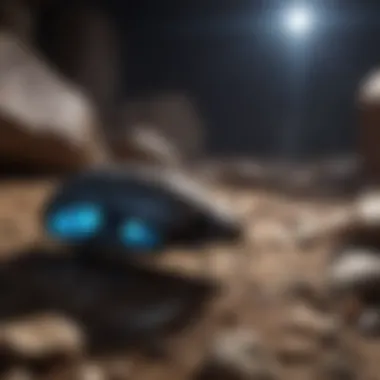Exploring the Science and Utility of UV Light Flashlights


Prologue
Ultraviolet (UV) light flashlights are specialized tools that emit light in the UV spectrum. These devices serve various functionalities across many fields. They are not limited to mere illumination; their potential stretches into forensics, pest control, and geological studies. Understanding how UV flashlights work and their applications represents an intersection of practicality and science that is of interest to collectors and professionals alike. This article will explore these diverse aspects, from the workings of UV flashlights to their significance in collecting minerals and fossils.
Overview of the Topic
Definition of Key Terms
When discussing UV light, one must first understand a few key terms. Ultraviolet light is a type of electromagnetic radiation that has a wavelength shorter than visible light but longer than X-rays. It is categorized into three types: UVA, UVB, and UVC.
- UVA: The longest wavelength, which is less harmful and can penetrate the skin deeply.
- UVB: Responsible for sunburn and has medium wavelength.
- UVC: The shortest wavelength, often used in disinfection and is absorbed by the Earth’s atmosphere.
A flashlight is simply a portable hand-held electric light. When combined, a UV flashlight emits light that can fluoresce certain materials or reveal hidden details.
Historical Significance
The study of UV light dates back to the late 19th century when scientists observed its effects in various materials. Initially, UV lamps were used in medicine for sterilization and treating skin conditions. Over time, their applications expanded.
In the realm of collectibles, the ability to only detect minerals and fossils with specific fluorescence properties transformed the collection into a more dynamic experience. Collectors can use UV flashlights to unveil hidden features of specimens, thereby increasing their value and interest.
Functionalities of UV Flashlights
The primary function of UV light flashlights is to enhance the visibility of certain materials. They can reveal biological stains in forensic investigations or detect counterfeit currency by exposing specific inks.
- Forensic Applications: Detects bodily fluids, fingerprints, and other evidence at crime scenes.
- Pest Control: Used to attract certain insects, aiding in pest management strategies.
- Educational Purposes: They assist students and collectors in learning about mineralogy by highlighting specific aspects of rock and fossil specimens.
"The utility of UV light in diverse fields demonstrates the evolving nature of technology and its applications in everyday life."
Epilogue
As we delve further into this article, we will explore more detailed applications and the science behind how UV light flashlights work. Each section will uncover the significance of this tool and its various uses in not just professional fields but also in the niche market of collectible minerals and fossils.
Foreword to UV Light Flashlights
Ultraviolet (UV) light flashlights represent a unique technology that has significant implications across various fields. Understanding the utility of these devices is essential, especially for those who engage in activities like rock and fossil collecting. Such flashlights extend beyond mere illumination; they enhance our ability to observe materials in a markedly different light. This unique capability allows collectors to identify mineral fluorescence and to discern intricate details not visible under regular light.
The prominence of UV light flashlights lies in their versatility. They serve critical roles in forensic science, pest detection, and even educational settings. Each application leverages the specific properties of UV light. They can reveal hidden elements within minerals or fossils, aiding collectors in their quest for knowledge and value. The significance of these flashlights also lies in their growing accessibility. As technology evolves, more individuals can acquire and use UV flashlights for various purposes.
Moreover, with increasing awareness of their applications, considerations around safety and usage practices become paramount. As enthusiasts adapt these tools for personal and professional use, understanding both the benefits and potential hazards of UV light is crucial. This section sets the stage for a deeper exploration of UV light's nature and how flashlight technology can harness its advantages.
Understanding the Spectrum of UV Light
Understanding the spectrum of UV light is crucial for appreciating the functionality and applications of UV light flashlights. This segment elucidates how different types of UV light contribute to various fields, including forensics and science education. Knowing the types and characteristics of UV light expands the capabilities of both amateur and professional users. It can guide decisions about flashlight selection depending on specific needs, such as detecting minerals or sterilizing surfaces.
Types of UV Light
UVA
UVA light represents the longest wavelength within the UV spectrum. It ranges from 320 to 400 nanometers. Its significant aspect is its ability to penetrate deep into the skin, which makes it essential for various applications. This characteristic is advantageous in photography and material authenticity checks, as certain substances exhibit fluorescence under UVA light. The unique feature of UVA flashlights is their widespread availability, often found in affordable consumer models. The primary disadvantage is that it does not have the same germicidal effectiveness as shorter wavelengths, thus limiting its use in sterilization tasks.
UVB


UVB light has a medium wavelength, between 280 and 320 nanometers. One of its key characteristics is that it mainly affects the outer skin layers, often causing sunburn. However, UVB is useful in detecting certain biological substances, such as bloodstains and bodily fluids, which fluoresce under its light. Its robust interaction with organic materials renders UVB flashlights suitable for forensic work. An important consideration is that prolonged exposure to UVB can pose health risks, making protective measures essential for users.
UVC
UVC light encompasses wavelengths from 100 to 280 nanometers. It is of paramount significance in sterilization processes, as it robustly destroys bacteria and viruses. The key characteristic of UVC is that it is highly effective against pathogenic microorganisms, thus making it beneficial for medical applications and surface sterilization. However, UVC poses greater risks of skin and eye damage, necessitating careful handling. UVC flashlights often come with safety features, but comprehensive protective measures should be taken when using them in various settings.
Wavelength and Intensity
The intensity and wavelength of UV light greatly influence its effectiveness and applications. The relationship between these factors determines how powerful a UV flashlight will be in specific tasks. Shorter wavelengths generally have higher energy and thus greater effectiveness in applications such as sterilization and fluorescence detection. Conversely, longer wavelengths may be better suited for purposes like mineral identification in collecting.
Understanding the interplay of wavelength and intensity is essential to maximize the use of UV flashlights. Collectors looking to enhance their abilities and insights into minerals should prioritize models that emit the appropriate wavelengths for their needs. Additionally, the measurement of intensity can guide users in evaluating how well their selected flashlight will perform, especially in darker environments or those with higher ambient light.
Applications of UV Light Flashlights
The applications of UV light flashlights span a range of fields, showcasing their versatility and practical implications. These devices serve unique purposes that enhance efficiency and accuracy in various domains. Understanding these applications offers insight into how UV flashlights contribute significantly to activities in forensic science, mineralogy, pest control, medicine, and even entertainment.
Forensic Science
In the realm of forensic science, UV light flashlights play a critical role in crime scene investigations. They help detect substances that are otherwise invisible to the naked eye. For instance, fluids such as blood and bodily fluids fluoresce under UV light due to their protein content. The UV light reveals these traces, allowing investigators to gather evidence that is crucial for solving crimes. Furthermore, UV flashlights can highlight fingerprints and other residues, enhancing the ability to process crime scenes with precision. This capability informs discussions about evidence integrity and contributes significantly to the judicial process.
Mineralogy and Collectible Identification
In mineralogy, UV light flashlights are invaluable for identifying minerals and distinguishing between similar-looking specimens. Specific minerals exhibit fluorescence when exposed to UV light, a phenomenon that can reveal their true nature or authenticity. This feature aids collectors and geologists in categorizing specimens accurately. Moreover, it can enhance the appreciation of the vibrancy and beauty held within various stones, especially in educational settings. Collectors often rely on UV light flashlights to verify the legitimacy of rare items and avoid the pitfalls of counterfeit specimens.
Pest Control and Detection
Another notable application is in pest control. UV light flashlights attract certain insects, making them useful for monitoring and trapping pests. This method supports integrated pest management strategies by providing a targeted approach to pest identification. Homeowners and professionals can use these devices to inspect areas for signs of pest infestations, improving overall pest management outcomes. Additionally, UV light helps in gauging the effectiveness of various pest control measures.
Medical and Sterilization Purposes
In the medical capacity, UV light flashlights have garnered attention for their germicidal properties. They are used to disinfect surfaces and equipment, particularly in clinics and laboratories. The ability of UV-C light to inactivate microorganisms is especially beneficial in maintaining hygiene standards. While UV flashlights are not the sole method of sterilization, they serve as an effective supplementary tool for ensuring environments remain sterile. Practitioners should consider safety protocols when implementing UV light to prevent adverse health effects.
Entertainment and Nightlife
In the entertainment sector, UV light flashlights enhance events, parties, and artwork presentations. They create striking visual effects, adding dimension and intrigue to environments, particularly in nightlife settings. Artists utilize UV light to highlight features that resonate with themes of nocturnality and fluorescence. Moreover, glow-in-the-dark materials used in various displays and decorations are often activated under UV light, enriching audience experiences. Users of UV light in these settings must be aware of proper safety measures to mitigate any risks associated with prolonged exposure to light.
The diversity of applications for UV light flashlights is a testament to their utility across numerous fields, each benefiting from the unique properties of UV light.
The Science Behind UV Light Flashlights
The role of science in understanding UV light flashlights is vital for appreciating their functionality and applications. This section will provide insights into how UV light is generated and how it interacts with various materials. Understanding these fundamental principles will help users, especially rock and fossil collectors, maximize the utility of UV light flashlights.
How UV Light is Generated
Ultraviolet light is produced by several methods, but in flashlights, it is primarily generated through the use of LEDs. Ultraviolet LEDs utilize a semiconductor that emits light when electrons recombine with holes in the material. This process produces light across different wavelengths, including the UV spectrum. The most common types of UV LEDs used in flashlights are UVA and UVC.
UVA is typically used for applications requiring longer wavelengths, which can be useful for detecting minerals. UVC, on the other hand, is often employed in sterilization and disinfection processes due to its germicidal properties. The efficiency of UV light generation has significantly improved with advancements in technology. As manufacturers develop better materials and techniques, the output of UV flashlights has increases, making them more effective for practical applications.
Photon Interaction with Materials
Once UV light is generated, its interactions with various materials are crucial for many of the applications discussed earlier. Photons, being packets of light energy, can induce various effects upon collision with matter. The specific interaction depends on the material's composition and the wavelength of the UV light.


Different minerals and compounds may respond to UV light differently:
- Fluorescence: Some materials absorb UV light and re-emit it as visible light. This property is incredibly useful for rock and fossil collectors in identifying and appreciating fluorescent specimens.
- Photodegradation: UV light can break down certain organic materials. This aspect is particularly significant in preservation and identification contexts.
- Absorption: Some materials do not fluoresce but may absorb UV light, leading to thermal excitation. This can sometimes provide insights into the sample's composition.
It is important to note that not all materials will react the same way to UV light. Therefore, understanding these interactions helps collectors distinguish between various specimens and determine their unique properties. Different wavelengths of light will affect minerals differently, which illuminates their contextual relevance in geological studies.
"The interaction of UV light with materials is foundational to many fields, including geology and forensic science. By understanding how UV light works, we can apply it more effectively in practical settings."
In summary, recognizing how UV light is generated and how it interacts with various materials is essential for users. For enthusiasts and professionals alike, especially those interested in collecting rocks and fossils, this scientific understanding enhances their experience and knowledge of their collections.
Safety Considerations
Addressing safety considerations in the context of UV light flashlights is crucial for users across various fields. While UV light offers unique benefits, it also poses certain hazards that require attention. Understanding protective measures and potential risks associated with UV exposure ensures the safe and effective use of these devices.
Protective Measures
When using UV light flashlights, implementing protective measures can significantly minimize risks. Here are several guidelines to follow:
- Wear Protective Eyewear: Specialized goggles designed to filter UV radiation can help protect your eyes from harmful light. Regular sunglasses do not provide adequate protection.
- Limit Skin Exposure: Cover exposed skin when using UV lights for extended periods. Wearing long sleeves and gloves can help prevent skin damage.
- Maintain Safe Distances: Keep the flashlight at a safe distance from skin and eyes. This reduces the intensity of UV exposure and its potential effects.
- Conduct Use in Controlled Environments: Use UV light flashlights in well-ventilated areas. This prevents prolonged exposure and facilitates monitoring of potential risks, keeping users aware of their surroundings.
"Awareness, paired with simple protective measures, greatly enhances safe practices when using UV light flashlights."
Potential Risks of UV Exposure
Despite the benefits of UV light, there are inherent risks associated with its exposure. Users should be cognizant of these dangers:
- Eye Damage: Prolonged exposure can lead to conditions like photokeratitis, or UV burn, which causes pain and temporary vision loss. Over time, this may contribute to cataract formation.
- Skin Harm: UV light can cause skin burns. Long-term exposure may lead to skin aging and increase the risk of skin cancers.
- Chemical Reactions: Some materials may react negatively to UV light, releasing harmful substances or altering their properties in unwanted ways.
- Temporary Disorientation: Intense UV light can cause a temporary blind spot, leading to accidents or mishaps in dimly lit areas.
Thus, understanding these potential risks is imperative for anyone using UV flashlights, especially in specific applications like mineralogy or forensic science. Safety practices must be prioritized to mitigate these hazards effectively.
By being informed and prepared, users can enjoy the advantages of UV light flashlights while minimizing health risks.
Choosing the Right UV Flashlight
Choosing the right UV flashlight is crucial for users, especially for rock and fossil collectors who rely on specific features for their activities. UV flashlights vary significantly in their capabilities and specifications. Thus, understanding what elements to prioritize ensures that you pick a flashlight that meets your needs effectively.
When selecting a UV flashlight, consider three primary factors: wavelength range, battery life, and durability. Each of these contributes uniquely to the flashlight's overall performance and user experience. Making informed decisions in these areas enhances the functionality of the flashlight, making it a valuable tool, whether for educational pursuits, pest control, or verifying mineral authenticity.
Factors to Consider
Wavelength Range
The wavelength range is a key aspect when assessing UV flashlights. UV light is divided into categories, with UVA, UVB, and UVC being the most notable. Each category plays a different role, affecting how materials respond to UV light.
For collectors, a flashlight that operates in the UVA range (approximately 320-400 nm) is often beneficial. This range is particularly effective in revealing the fluorescence in certain minerals and fossils, making it desirable within the collecting community.
The unique feature of UVA flashlights is their balance of effectiveness and safety. Unlike UVC, which can be harmful, UVA typically poses lower risks with proper use. However, it is important to note that while UVA wavelengths are less hazardous, prolonged exposure should still be avoided to protect skin and eyes.
Battery Life
Battery life is another crucial consideration when purchasing a UV flashlight. The duration the flashlight can run before needing a recharge or battery replacement impacts not just convenience but also efficiency in fieldwork.


Most collectors prefer flashlights with long-lasting batteries, as these can withstand long periods of exploration without interruption. A flashlight with a rechargeable lithium-ion battery tends to be a popular choice due to its longer life span and higher performance compared to alkaline batteries.
The unique feature of extended battery life is the additional time it allows for thorough inspections of specimens in the field. However, users must also consider the potential disadvantages, such as the charging time required for rechargeable batteries.
Durability
Durability is essential for any equipment that might face rough handling in various environments. A lightweight but robust design can make a significant difference over time.
High-quality UV flashlights are often built with materials such as aluminum, which provides strength while minimizing weight. An essential characteristic of durable flashlights is their ability to resist impacts, dust, and moisture, allowing reliable use in diverse conditions.
In the context of rock and fossil collection, a rugged flashlight adds significant utility. While it often comes with a higher price tag, the longevity and robust performance justify the investment. Ensuring that your UV flashlight is durable will assure its reliability during extended trips.
Comparing Different Models
When it comes to comparing different models of UV flashlights, the features, specifications, and user reviews can greatly assist in making an informed choice.
- Read product reviews: Observing firsthand accounts helps gauge performance across different environments.
- Look at specifications: Compare wavelengths, battery types, and additional features, such as intensity adjustment and weight.
- Test in stores: If possible, hold the flashlight and assess its feel and ease of use.
Choosing a UV flashlight requires careful consideration of specific features that will enhance your activity as a rock and fossil collector. By emphasizing wavelength range, battery longevity, and durability, guides consumers in selecting a flashlight that meets their requirements.
Technological Advancements in UV Flashlight Design
Recent innovations in UV flashlight design have opened up new possibilities for various applications, ranging from scientific research to everyday utility. Understanding these advancements is crucial for rock and fossil collectors, as they enhance the effectiveness and versatility of UV light tools. The integration of new technologies is not just about performance; it also impacts usability, safety, and overall user experience.
LED Technology and UV Flashlights
LED technology represents a significant leap in UV flashlight efficiency. Traditional incandescent lamps are being replaced by LEDs, which consume less energy while providing longer lifespans. The typical lifespan of a UV LED can exceed 25,000 hours, making it a favorable choice. Moreover, LEDs can produce specific wavelengths of UV light more precisely than other light sources. This is important for applications like mineral identification where specific wavelengths trigger fluorescence, revealing details unseen under standard light.
LEDs are also more resistant to shock and vibrations, making them ideal for outdoor environments. They generate minimal heat as well, which can be a safety factor in prolonged usage. This shift toward LED technology is critical for enhancing the overall performance and reliability of UV flashlights in collecting activities.
Innovative Features
Rechargeable Batteries
Rechargeable batteries are a key innovation that enhances the practicality of UV flashlights. Unlike disposable batteries, rechargeable options offer cost-effectiveness and environmental advantages. They reduce waste and the need for frequent battery replacements, which is beneficial for users who rely on these tools over time.
One of the standout characteristics of rechargeable batteries is their capacity to provide consistent power output over a longer duration. Many updated UV flashlights now include smart charging capabilities that prevent overcharging and extend battery life. This feature ensures that collectors can focus on their activities without worrying about power depletion. However, it is essential to consider the charging time, as some models may require several hours to fully recharge.
Adjustable Intensity
Adjustable intensity is another significant advancement in UV flashlight technology. This feature allows users to modify the brightness of the UV light emitted. This is useful for different tasks; for example, a higher intensity may be optimal for detecting certain minerals during daylight, while lower intensity might suffice in darker conditions.
The versatility of adjustable intensity enhances customization. Collectors can tailor the light to their specific needs without compromising visibility or exposure. However, one drawback could be the complexity it adds to the flashlight's operation. Users must familiarize themselves with settings to optimize their experience, which can be a consideration for those who prefer simplicity.
"Technological advancements make UV light flashlights more efficient, reliable, and user-friendly for various applications."
End
The conclusion of an article serves several critical functions. It encapsulates the main points discussed and reinforces the significance of the topic. In this case, the exploration of UV light flashlights sheds light on both their practical applications and the underlying science that supports their functionality. It is essential to recognize the multifaceted benefits these tools bring to various fields.
The Future of UV Technology
Advancements in UV technology are poised to redefine how we understand and utilize UV light flashlights. Innovations may emerge that enhance energy efficiency while expanding wavelength ranges. These improvements can lead to a broader array of applications, from medical diagnostics to improved pest control methods. Moreover, ongoing research into safer materials and protective measures will likely foster more effective devices, ensuring user safety is a priority. R&D in nanotechnology could yield compact designs, making UV flashlights more accessible and user-friendly for both professionals and enthusiasts.
Recap of Applications and Safety
To summarize, UV light flashlights serve numerous practical purposes across diverse sectors. Forensic scientists rely on them for evidence collection, while mineralogists use them to identify rock specimens based on fluorescent properties. Furthermore, the pest control industry benefits from the ability to detect infestations more effectively. However, it is important to balance these applications with an understanding of safety. Users must take protective measures to avoid excessive exposure, as prolonged UV exposure poses health risks. Overall, as technology progresses, the dual focus on functionality and safety will ensure that UV light flashlights remain invaluable tools in their respective fields.















